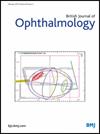Use of patient-reported outcomes in ophthalmology clinical trials between 2014 and 2023
IF 3.5
2区 医学
Q1 OPHTHALMOLOGY
引用次数: 0
Abstract
Background/aims Patient-reported outcomes (PROs) evaluate health and functional status, and PRO measures (PROMs) are standardised tools for measuring PROs. Together, they provide valuable insights into treatment efficacy, safety and practicality not captured by traditional clinical endpoints. This cross-sectional analysis with a systematic search component aims to investigate the use, interpretation and reporting of PROs and PROMs in ophthalmic randomised controlled trials (RCTs). Methods Ophthalmic RCTs published in the top 10 highest impact factor ophthalmic and medical journals between 2014 and 2023 were systematically reviewed. The frequency of PRO inclusion and adherence to Consolidated Standards of Reporting Trials (CONSORT) PRO guidelines was assessed. The relationship between PRO utilisation and study-level and journal-level characteristics was explored with multivariable regression. Results Among 9436 records screened, 333 RCTs met eligibility criteria. Of these, 87 (26.1%) included PROs, and 28 (8.4%) used them as primary outcomes. Most studies (83/87, 95.4%) leveraged PROMs, with ophthalmology-specific tools predominating (73.5%). Minimal important differences (MIDs) were rarely used (2.3%) for PRO interpretation. At least 8/13 CONSORT PRO Extension items were reported in 33.3% studies, and trials with primary PRO endpoints had better adherence (p<0.001). PRO utilisation was less likely in trials with lower 5-year journal impact factor (adjusted OR (aOR) 0.99, 95% CI 0.98 to 1.00, p=0.037) and pharmaceutical compared with health service interventions (aOR 0.15, 95% CI 0.03 to 0.67, p=0.013). Conclusions PRO integration and interpretation remain limited in high-impact ophthalmic RCTs, despite offering a meaningful adjunct to objective endpoints. Future trials should adopt validated and condition-specific PROMs and establish MIDs to enhance interpretation. Data are available on reasonable request.2014年至2023年眼科临床试验中患者报告结果的使用
背景/目的患者报告预后(PRO)评估健康和功能状态,PRO测量(PROMs)是衡量PRO的标准化工具。总之,它们为传统临床终点无法捕捉到的治疗疗效、安全性和实用性提供了有价值的见解。本横断面分析与系统搜索组件旨在调查眼科随机对照试验(rct)中PROs和prom的使用、解释和报告。方法对2014 ~ 2023年影响因子排名前10位的眼医学期刊发表的眼科随机对照试验进行系统回顾。评估PRO纳入的频率和对合并标准报告试验(CONSORT) PRO指南的依从性。使用多变量回归探讨PRO利用与研究水平和期刊水平特征之间的关系。结果9436条记录中,333条rct符合入选标准。其中87例(26.1%)纳入了PROs, 28例(8.4%)将其作为主要结局。大多数研究(83/87,95.4%)利用PROMs,其中眼科专用工具占主导地位(73.5%)。最小重要差异(mid)很少用于PRO解释(2.3%)。33.3%的研究报告了至少8/13个CONSORT PRO扩展项目,具有主要PRO终点的试验具有更好的依从性(p<0.001)。与卫生服务干预相比,5年期刊影响因子较低的试验(调整OR (aOR) 0.99, 95% CI 0.98至1.00,p=0.037)和药物干预(aOR 0.15, 95% CI 0.03至0.67,p=0.013)中PRO的利用可能性较小。结论:尽管为客观终点提供了有意义的辅助手段,但在高影响眼科随机对照试验中,PRO的整合和解释仍然有限。未来的试验应采用经过验证的和特定条件的prom,并建立mid以加强解释。如有合理要求,可提供资料。
本文章由计算机程序翻译,如有差异,请以英文原文为准。
求助全文
约1分钟内获得全文
求助全文
来源期刊
CiteScore
10.30
自引率
2.40%
发文量
213
审稿时长
3-6 weeks
期刊介绍:
The British Journal of Ophthalmology (BJO) is an international peer-reviewed journal for ophthalmologists and visual science specialists. BJO publishes clinical investigations, clinical observations, and clinically relevant laboratory investigations related to ophthalmology. It also provides major reviews and also publishes manuscripts covering regional issues in a global context.

 求助内容:
求助内容: 应助结果提醒方式:
应助结果提醒方式:


